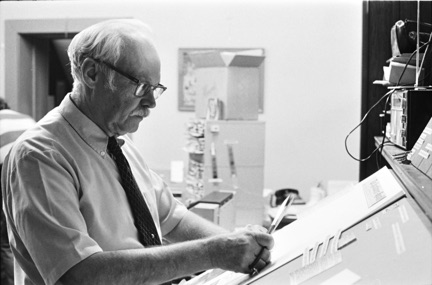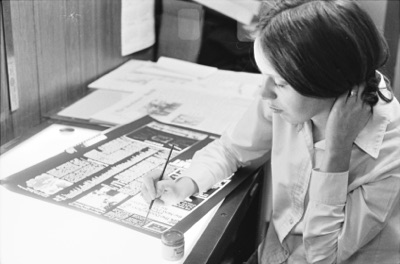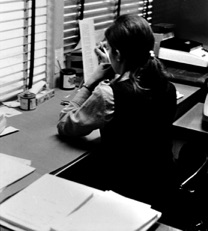it goes without saying
That a lot of the cold type work took place in a darkroom.
Paul Bearer handled virtually all of the graphic arts stuff (and got to have bright red lights to work by; I envied that.)

Of course, I have no pictures of myself working with pan film, but my piece of the darkroom was crammed back under a stairway and most of the space was consumed by an Omega D-2 that was probably built my Mr. Simmons with his own hands.
Prints for the halftone process were made on a stabilization processor, because they only had to last a day or two. It was surprising to me how long they really did last.
In honor of tradition, those prints were called "Veloxes" because this whole thing goes back to contact prints from gargantuan negatives.
Copy was written on a typewriter that punched a paper tape that was then run through a similar machine that typed it out on clay-coated paper (really white) and justified.
If you think that is clumsy,, you probably never used a Linotype.


Trim to size, put adhesive wax on the back, and paste it up.
Everybody did some or a lot of this, but only Dave wore a tie. He ALWAYS wore a tie.

He was a walking dictionary and thesaurus, and he was never wrong.
If you were unsure how to spell something, all you had to do was say the word out loud, and the spelling came right back in a cadence that lives on in my head to this day...
"Journalist"
"Jay.. Oh..you..are <pause> En... Aye <pause> Ell...Eye...Ess...Tee"
He was a stickler for grammar and spelling, and I am forever grateful for the schooling he gave me in those areas.
The full page composites went back to Paul's process camera and a full page negative.
Then some lucky person got to opaque-out all the damned little pinholes and dust spots.
On occasion I got in on this to make a strategic improvement to a pictrure, but that was rare.


Did I mention proofreading? Again and again. And again. And again. And some more. All of us were collectively mortified when a typo got into print.

